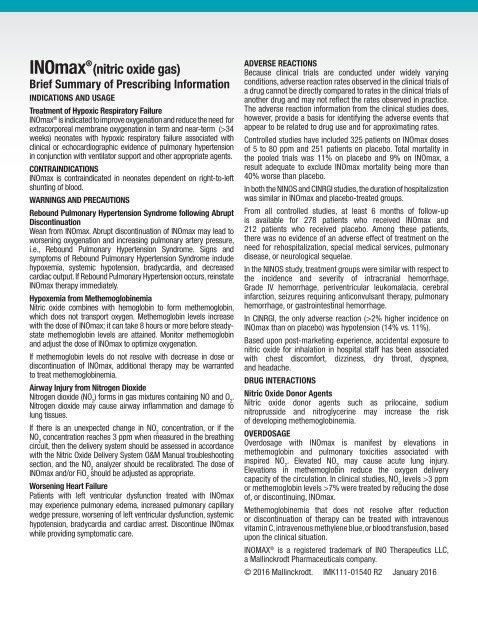INTENSIVE CARE
8dI2AMDUa
8dI2AMDUa
You also want an ePaper? Increase the reach of your titles
YUMPU automatically turns print PDFs into web optimized ePapers that Google loves.
INOmax ® (nitric oxide gas)<br />
Brief Summary of Prescribing Information<br />
INDICATIONS AND USAGE<br />
Treatment of Hypoxic Respiratory Failure<br />
INOmax ® is indicated to improve oxygenation and reduce the need for<br />
extracorporeal membrane oxygenation in term and near-term (>34<br />
weeks) neonates with hypoxic respiratory failure associated with<br />
clinical or echocardiographic evidence of pulmonary hypertension<br />
in conjunction with ventilator support and other appropriate agents.<br />
CONTRAINDICATIONS<br />
INOmax is contraindicated in neonates dependent on right-to-left<br />
shunting of blood.<br />
page 8<br />
Rebound Pulmonary Hypertension Syndrome following Abrupt<br />
WARNINGS AND PRECAUTIONS<br />
Discontinuation<br />
Wean from INOmax. Abrupt discontinuation of INOmax may lead to<br />
worsening oxygenation and increasing pulmonary artery pressure,<br />
i.e., Rebound Pulmonary Hypertension Syndrome. Signs and<br />
symptoms of Rebound Pulmonary Hypertension Syndrome include<br />
hypoxemia, systemic hypotension, bradycardia, and decreased<br />
cardiac output. If Rebound Pulmonary Hypertension occurs, reinstate<br />
INOmax therapy immediately.<br />
Hypoxemia from Methemoglobinemia<br />
Nitric oxide combines with hemoglobin to form methemoglobin,<br />
which does not transport oxygen. Methemoglobin levels increase<br />
with the dose of INOmax; it can take 8 hours or more before steadystate<br />
methemoglobin levels are attained. Monitor methemoglobin<br />
and adjust the dose of INOmax to optimize oxygenation.<br />
If methemoglobin levels do not resolve with decrease in dose or<br />
discontinuation of INOmax, additional therapy may be warranted<br />
to treat methemoglobinemia.<br />
Airway Injury from Nitrogen Dioxide<br />
Nitrogen dioxide (NO 2<br />
) forms in gas mixtures containing NO and O 2<br />
.<br />
Nitrogen dioxide may cause airway inflammation and damage to<br />
lung tissues.<br />
If there is an unexpected change in NO 2<br />
concentration, or if the<br />
NO 2<br />
concentration reaches 3 ppm when measured in the breathing<br />
circuit, then the delivery system should be assessed in accordance<br />
with the Nitric Oxide Delivery System O&M Manual troubleshooting<br />
section, and the NO 2<br />
analyzer should be recalibrated. The dose of<br />
INOmax and/or FiO 2<br />
should be adjusted as appropriate.<br />
Worsening Heart Failure<br />
Patients with left ventricular dysfunction treated with INOmax<br />
may experience pulmonary edema, increased pulmonary capillary<br />
wedge pressure, worsening of left ventricular dysfunction, systemic<br />
hypotension, bradycardia and cardiac arrest. Discontinue INOmax<br />
while providing symptomatic care.<br />
ADVERSE REACTIONS<br />
Because clinical trials are conducted under widely varying<br />
conditions, adverse reaction rates observed in the clinical trials of<br />
a drug cannot be directly compared to rates in the clinical trials of<br />
another drug and may not reflect the rates observed in practice.<br />
The adverse reaction information from the clinical studies does,<br />
however, provide a basis for identifying the adverse events that<br />
appear to be related to drug use and for approximating rates.<br />
Controlled studies have included 325 patients on INOmax doses<br />
of 5 to 80 ppm and 251 patients on placebo. Total mortality in<br />
adpage<br />
the pooled trials was 11% on placebo and 9% on INOmax, a<br />
result adequate to exclude INOmax mortality being more than<br />
40% worse than placebo.<br />
In both the NINOS and CINRGI studies, the duration of hospitalization<br />
was similar in INOmax and placebo-treated groups.<br />
From all controlled studies, at least 6 months of follow-up<br />
is available for 278 patients who received INOmax and<br />
212 patients who received placebo. Among these patients,<br />
there was no evidence of an adverse effect of treatment on the<br />
need for rehospitalization, special medical services, pulmonary<br />
disease, or neurological sequelae.<br />
In the NINOS study, treatment groups were similar with respect to<br />
the incidence and severity of intracranial hemorrhage,<br />
Grade IV hemorrhage, periventricular leukomalacia, cerebral<br />
infarction, seizures requiring anticonvulsant therapy, pulmonary<br />
hemorrhage, or gastrointestinal hemorrhage.<br />
In CINRGI, the only adverse reaction (>2% higher incidence on<br />
INOmax than on placebo) was hypotension (14% vs. 11%).<br />
Based upon post-marketing experience, accidental exposure to<br />
nitric oxide for inhalation in hospital staff has been associated<br />
with chest discomfort, dizziness, dry throat, dyspnea,<br />
and headache.<br />
DRUG INTERACTIONS<br />
Nitric Oxide Donor Agents<br />
Nitric oxide donor agents such as prilocaine, sodium<br />
nitroprusside and nitroglycerine may increase the risk<br />
of developing methemoglobinemia.<br />
OVERDOSAGE<br />
Overdosage with INOmax is manifest by elevations in<br />
methemoglobin and pulmonary toxicities associated with<br />
inspired NO 2<br />
. Elevated NO 2<br />
may cause acute lung injury.<br />
Elevations in methemoglobin reduce the oxygen delivery<br />
capacity of the circulation. In clinical studies, NO 2<br />
levels >3 ppm<br />
or methemoglobin levels >7% were treated by reducing the dose<br />
of, or discontinuing, INOmax.<br />
Methemoglobinemia that does not resolve after reduction<br />
or discontinuation of therapy can be treated with intravenous<br />
vitamin C, intravenous methylene blue, or blood transfusion, based<br />
upon the clinical situation.<br />
INOMAX ® is a registered trademark of INO Therapeutics LLC,<br />
a Mallinckrodt Pharmaceuticals company.<br />
© 2016 Mallinckrodt. IMK111-01540 R2 January 2016


